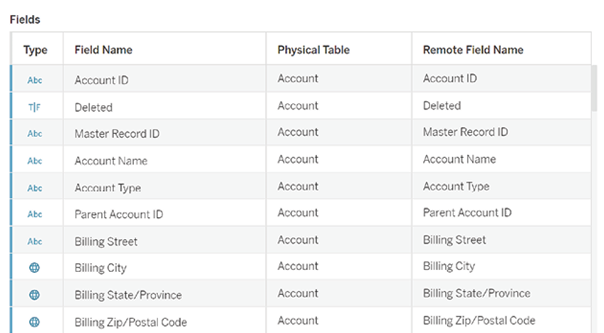Congratulations on managing to connect to your Salesforce data! You are now in your data tab, and these are its components:
- Standard Connection list: If you are using the Salesforce connector, here you will be able to see a list of the most used data feeds.
- Table list: This is the list of all the tables available in Salesforce for your analysis.
- Search function: By clicking on this icon and starting to type, Tableau will filter the table list until you see the one you need.
- Main data area: This is where you will drag your tables and create your dataset.
- Data preview area: Once you have dragged a table, this is where you will see the list of fields in your table and related information.
- Connection: Here, you can choose to use a live connection or an extract.
Basic data manipulations in the data screen
To start working with your data, simply choose any of the objects on the left side of the screen and drag it to the main area. If you cannot immediately see the table you are looking for on the left side of the screen, you can use the search function on top of the list of table names. Simply start typing, and the list will be filtered accordingly, as shown in Figure 3.9:

Figure 3.9: Using the search function in Tableau to filter the list of tables
On the lower part of your screen, you should now see more information about the table you just added. In particular, the following information should be available (as shown in Figure 3.10):
- Data type: Tableau will look at your data and decide how to categorize it among the following data types:
- String: For text fields.
- Numeral (integer): For whole numbers without decimals.
- Numeral (decimal): For numbers with decimals.
- Geographical value: This is the type of data that allows Tableau to create maps and store geographical information. More about this in the maps section of this book.
- Date & time: For date fields, which also contain times.
- Date: For date fields without times.
- Field Name: The name of the field as it is read by Tableau.
- Physical table: The name of the table in which the field is stored, useful when working with more than one table.
- Remote Field Name: The field’s “original” name in the table. Useful in case a field has been renamed or an alias is used.

Figure 3.10: Tableau interpreting and categorizing data types
